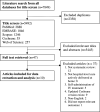Comparison of Hospital-at-Home models: a systematic review of reviews
- PMID: 33514582
- PMCID: PMC7849878
- DOI: 10.1136/bmjopen-2020-043285
Comparison of Hospital-at-Home models: a systematic review of reviews
Abstract
Objectives: To provide an overview of the safety and effectiveness of Hospital-at-Home (HaH) according to programme type (early-supported discharge (ESD) vs admission avoidance (AA)), and identify the model with higher evidence for addressing clinical, length of stay (LOS) and cost outcomes.
Methods: A systematic review of reviews was conducted by performing a search on PubMed, EMBASE, Cochrane Database of Systematic Reviews, Web of Science and Scopus (January 2005 to June 2020) for English-language systematic reviews evaluating HaH. Data on primary outcomes (mortality, readmissions, costs, LOS), secondary outcomes (patient/caregiver outcomes) and process indicators were extracted. Quality of the reviews was assessed using Assessment of Multiple Systematic Reviews-2. There was no registered protocol.
Results: Ten systematic reviews were identified (four high quality, five moderate quality and one low quality). The reviews were classified according to three use cases. ESD reviews generally revealed comparable mortality (RR 0.92-1.03) and readmissions (RR 1.09-1.25) to inpatient care, shorter hospital LOS (MD -6.76 to -4.44 days) and unclear findings for costs. AA reviews observed a trend towards lower mortality (RR 0.77, 95% CI 0.54 to 1.09) and costs, and comparable or lower readmissions (RR 0.68-0.98). Among reviews including both programme types (ESD/AA), chronic obstructive pulmonary disease reviews revealed lower mortality (RR 0.65-0.68) and post-HaH readmissions (RR 0.74-0.76) but unclear findings for resource use.
Conclusion: For suitable patients, HaH generally results in similar or improved clinical outcomes compared with inpatient treatment, and warrants greater attention in health systems facing capacity constraints and rising costs. Preliminary comparisons suggest prioritisation of AA models over ESD due to potential benefits in costs and clinical outcomes. Nonetheless, future research should clarify costs of HaH programmes given the current low-quality evidence, as well as address evidence gaps pertaining to caregiver outcomes and adverse events under HaH care.
Keywords: health services administration & management; organisation of health services; quality in health care.
© Author(s) (or their employer(s)) 2021. Re-use permitted under CC BY-NC. No commercial re-use. See rights and permissions. Published by BMJ.
Conflict of interest statement
Competing interests: None declared.
Figures
References
Publication types
MeSH terms
LinkOut - more resources
Full Text Sources
Other Literature Sources
Medical
Miscellaneous

